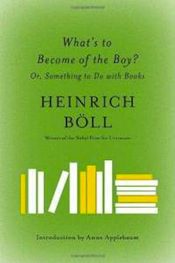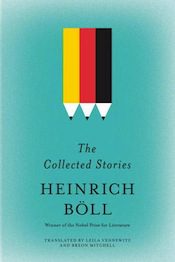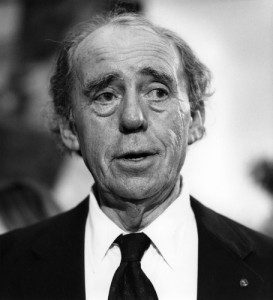
In one of her letters, Flannery O’Connor noted that many Catholics end up suffering as much or more from the Church itself as from those who oppose it and its beliefs. This came to mind more than once as I read these two books, part of what Melville House Publishing calls “The Essential Heinrich Böll,” which also includes six other works. Böll, in the words of the publisher, “the first German to win the Nobel Prize for literature since Thomas Mann in 1929,” was born in Cologne in 1917 and raised in a liberal pacifist Catholic family.
You would expect with such a background that during the rise of Nazi power that his family would have suffered. But the Church, too often, only added to the suffering, as when the Church made a Concordat with Hitler, which Böll writes about in his memoir of his adolescent years (1933-1937) before the outbreak of World War II, What’s to be Done with the Boy?
After the seizure of power, the Reichstag fire, and the March election, it was, incredibly, the Vatican that accorded the Nazis their first major international recognition. Some members of our family—myself among them—seriously considered leaving the church, but that had become so fashionable among all those Germans who couldn’t wait to join the Nazi Party after the March 1933 election that we didn’t, since it might have been misconstrued as homage to the Nazis.
Böll refused to join the Hitler Youth or any Nazi organization, as did all the family. However during a family meeting, they decided that one of them would have to join to keep up appearances, and to keep the family business—Böll’s father was a cabinet maker and sculptor who needed government contracts—going. They were walking a fine line between open rebellion, which would have sent them to the concentration camps, and acceptance of the Nazis, which they weren’t capable of, for the Böll family hated the Nazis and everything they stood for. “My mother,” Böll writes, “hated Hitler from the beginning (unfortunately she didn’t live to see his death); she dubbed him Rövekopp, ‘turnip head,’ an allusion to the traditional St. Martin’s torches roughly carved from sugar beets and leaving, wherever possible, something resembling a moustache.”
Böll’s memoir tells of how those years passed in hunger, poverty, and fear, as well as in black market activities, friendships, study, and raucous family gatherings that included lots of smoking, drinking, and gossiping, at the end of which someone always said, “Okay, let’s be Christians again.” Böll makes clear that he was never brave about what he terms his allergy to Nazism, that he was not a heroic resister such as Bonhoeffer; rather he was alienated, he writes, more and more by everything around him. As Anne Applebaum writes in her introduction to the memoir, Böll has an “occasionally sanctimonious vision of himself,” holds himself aloof, but he is honest about it, knows it about himself.
Toward the very end of the memoir, Böll writes of how one of his friends, Caspar Markard, both a staunch Catholic and anti-Nazi, took him to meet a priest, Robert Grosche, who hosted weekly seminars for students.
Grosche, the classic Rhinelander, the classic highly educated abbé, the Claudel translator and expert, one of Germany’s first truly ecumenical priests, yet intensely Roman: his study crammed with books and always filled with pipe smoke, was an island that fascinated and at the same time intimidated me.
But all that “cultural composure” bothered him. “It was tremendous to be there, to be with him, but it was not what I was looking for.”
What, then, was Böll looking for? At another family meeting, when it was asked what was to be done with the boy, someone said it would have to do something with books. Somehow Böll found an apprenticeship with a bookseller and enjoyed the work, but then war broke out and he was conscripted into World War II. It turns out he was writing even then, though; a story called “Youth on Fire,” was written in 1937 when he was still in high school and appeared posthumously. It reads like the script of a Robert Bresson movie, and, as the translator Breon Mitchell writes in his introduction, “Its striking chords of youthful idealism, the search for spiritual meaning, and the role of the Catholic Church already seem familiar, as do a keen eye for telling detail, a deep sympathy for the poor, and an impatience with social conventions and mores.”
 Böll fought on the Russian and French fronts, was wounded four times, and ended up in an American POW camp. When he came back to Cologne, where he had lived all his life, he tried university but turned back to writing and never looked back. The Collected Stories is 964 pages long and comprises eight previously published books.
Böll fought on the Russian and French fronts, was wounded four times, and ended up in an American POW camp. When he came back to Cologne, where he had lived all his life, he tried university but turned back to writing and never looked back. The Collected Stories is 964 pages long and comprises eight previously published books.
Almost all of Böll’s stories portray the war or the aftermath of the war: of how soldiers fought, fell in love, deserted, and forged documents to obtain leave (Böll, it appears, was an expert at this); of how they lived with one another and sometimes killed one another; of how seeming chance made the difference between life and death; of how the survivors lived and coped with their memories and the terrible years for Germany right after the war. Some of the combat stories struck me as melodramatic and overdone—you know one protagonist is going to be killed at the story’s end, in first person no less!—but Böll’s artistry keeps you reading, and the heart and vividness of the prose caused me, at least, to forgive him more than once. It’s the same for a few stories that were too preachy for me, but the storyteller in Böll is always more powerful than the preacher.
The story that struck me the hardest was “Cause of Death: Hooked Nose,” included in the book of stories, The Casualty, published in 1983. It concerns a German soldier, Lieutenant Hegemüller, who tries to save the life of a Russian soldier, Grimschenko, who has been mistaken as a Jew because of his hooked nose. The Jews are being mowed down with machine-pistol fire at the edge of a quarry that they then tumble into. Grimschenko’s mother pleads with Hegemüller to find her son before it is too late and he runs through the empty streets in the direction of gun fire and comes upon the sentry guarding the entrance to the nightmarish scene, “where the doomed had been herded together at the edge of the steppe”:
. . . the faces of the sentry cordon seemed all equally dull-witted and brutish whereas the faces of those inside the cordon seemed in some exquisite manner to have been lifted high above the mass and placed on the pinnacle of humanity. A sombre silence hung over the crowd, something strangely vibrating, fluttering, like the flapping of heavy banners, something solemn, and—Hegemüller felt, as his heart missed a beat—inexplicable comforting, joyful; he felt this joy surge through him, and at that instant he envied the doomed people and was shocked to realize that he was wearing the same uniform as the murderers.
He is too late to save the life of Grimschenko, but he hoists the dying man over his shoulder and has him taken to a field hospital whereupon he faints from exhaustion and trauma. He wakes to hear a doctor joking about the cause of Grimschenko’s death being a hooked nose. Hegemüller cracks up mentally at that point and laughs hysterically “and from then on the only words he ever spoke were: ‘Cause of death: hooked nose.’”

Now, for me, the story was wrenching and powerful enough that that last line seems melodramatic or a little too much. On the other hand, why wouldn’t a normal person not go insane seeing what he’s seen? At one point, while looking for Grimschenko, he keeps wondering: “What do they do with the babies, the tiny ones who can’t stand or walk—how is it technically possible?” A little later, “he saw the answer to that nagging question. He saw a black boot kicking the bloodied corpse of an infant into the abyss . . . “
Böll’s writing is filled with a bleak beauty that unflinchingly gazes upon the sources of both the bleakness and the beauty of life, thus offending both the moralists and the literati. He and other German writers were accused of writing what was disparagingly called Rubble Literature. Böll responded to his critics in his essay, “In Defense of Rubble Literature”:
The writer’s eye should be human and incorruptible . . . we want to see things the way they are, with a human eye that normally is not quite dry or wet, but damp . . . It is our task to remind the world that a human being exists for something more than to be bureaucratized—and that the destruction in our world is not merely external or so trivial that we can presume to heal it within a few years.
Throughout our Western culture the name of Homer is above suspicion: Homer is the progenitor of the European epic, yet Homer tells of the Trojan War, of the destruction of Troy, and of Ulysses’ homecoming—a literature of war, rubble, and homecoming. We have no reason to be ashamed of these labels.
Flannery O’Connor, it seems to me, suffered from the Church’s occasional (some would say frequent) vulgarity, smugness, and anti-intellectualism; Böll from its complacency, corruption, and conformism. But for both it provided the living context for finding the meaning in their and the world’s suffering. Böll’s work in these two books, however, is not parochial in any sense. His writing truly embraces all of reality and seeks the truth of the way things are beyond or unfettered by any beliefs.




